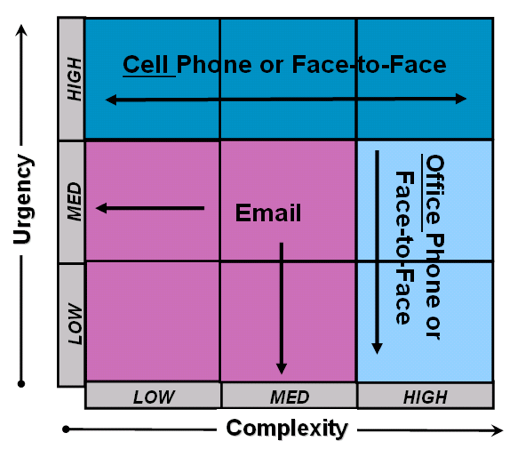In last week's blog post, I wrote that Jeff Kindler, the former CEO of Pfizer, was
thoughtless about the demands his communication style placed on his team and the results of that style. By making all his questions a matter of supreme urgency for his team — and let’s face it, communicating via BlackBerry at all hours of the night screams, "PAY ATTENTION! I’M IMPORTANT!" — he sowed the seeds of his own demise. Part of your role as a leader is to help people distinguish among levels of urgency and importance. Cramming everything through one communication channel — whether that’s email, IM, text message, or meetings — is a recipe for disaster.
One of my clients has taken this concept to heart. They don't have a leader who abuses his BlackBerry, but they do have an awful lot of engineers who are drowning like rats in the flood of communication -- particularly phone calls and emails -- within and between their teams. As a result, they can't distinguish between critical and time-sensitive issues like a major product flaw, and trivialities like the new flavor of coffee that they company has put in the machines.
Their situation is hardly unique, of course. But unlike most groups who simply wave their hands inertly and bemoan their fate, they're actually doing something about it. This is their new communication protocol:

Okay, this protocol isn't a breakthrough along the lines of, say, cold fusion. (Or duct tape. Or Oreos, for that matter.) But it does create clear expectations and guidelines to help the engineers manage the communication and information flow that was previously threatening to inter them.
Pay attention to one critical consequence here: everyone has agreed that email is NOT to be used for urgent or complex issues. This agreement really is significant, because it unshackles people from their BlackBerries during meetings, or product development work, or strategic planning. Or their kids' soccer games. Or dinner. Or sex. Which means that there's now a fighting chance to have some uninterrupted time to, you know, think.
This protocol might not work for you. Every company has an idiosyncratic culture and needs. The important thing isn't how you define your communication protocol, but that you define it. And while this might not be perfect, so far it's been a pretty good life preserver for all those drowning rats.
Now, what are your guidelines?
